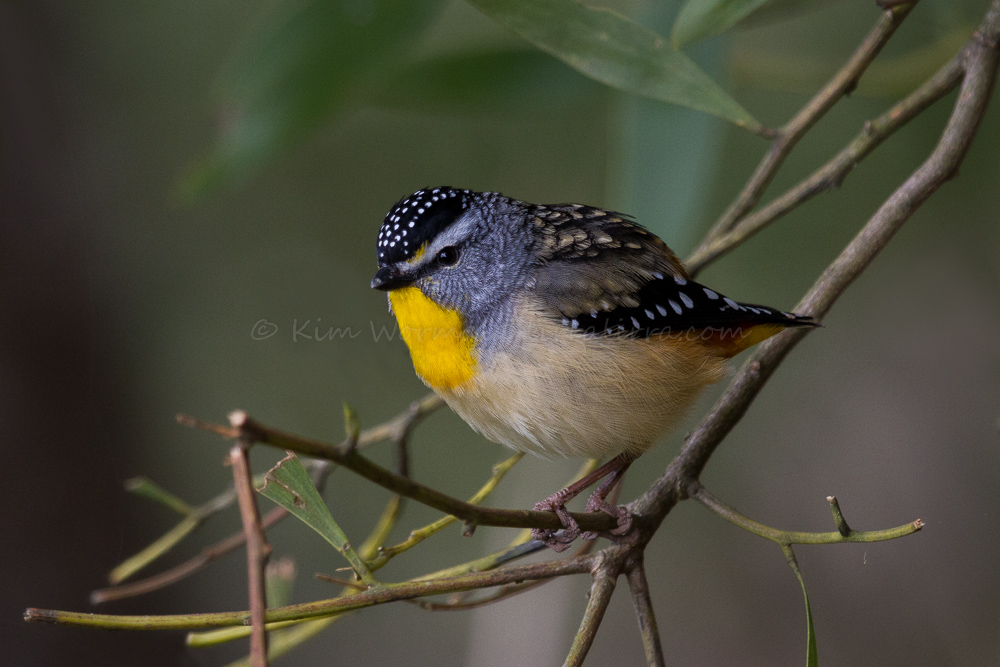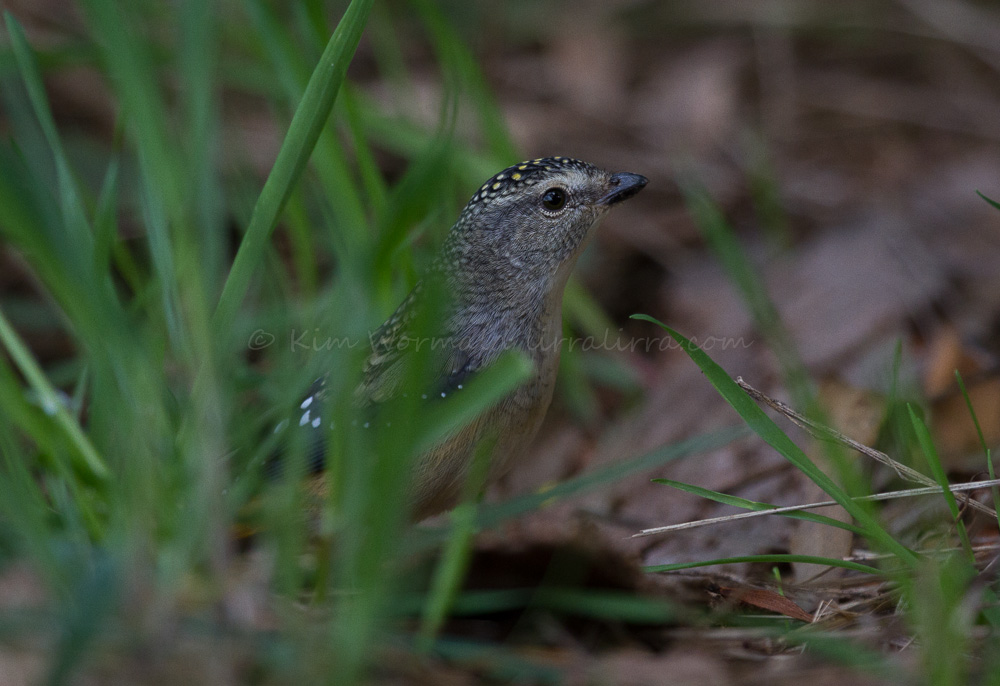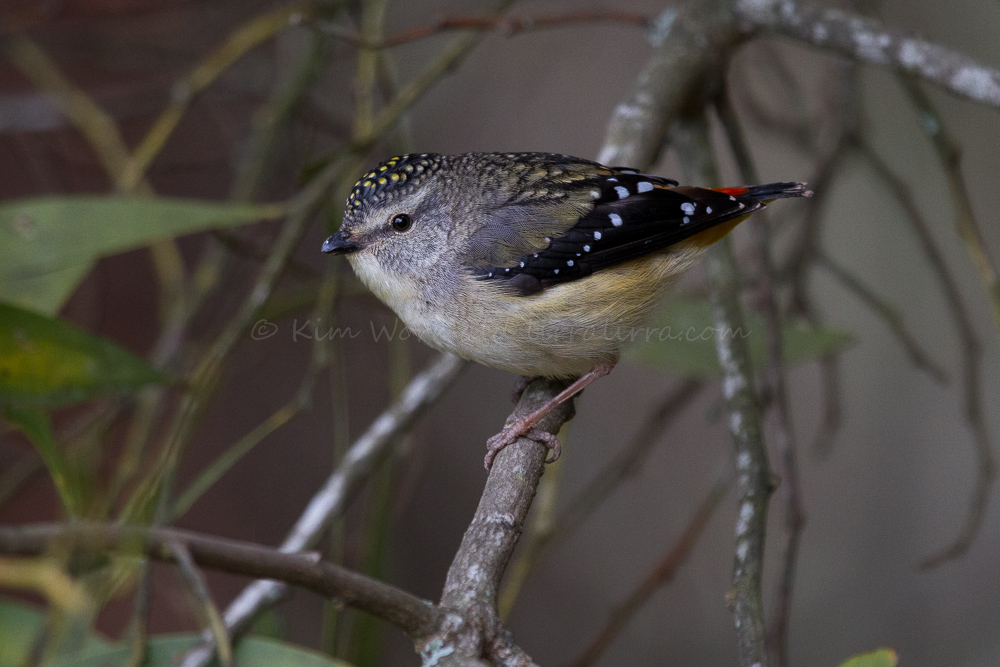Imagine spooning two teaspoons of granulated sugar into the palm of your hand – at 8 grams you would hardly know it was there and yet it would weigh the same as a Spotted Pardalote.
 Spotted Pardalote (Pardalotus punctatus) – male
Spotted Pardalote (Pardalotus punctatus) – male
Canon 7D, 100-400mm L IS USM, 1/500, f/5.6, ISO 640
Spotted Pardalotes are arguably Australia’s most beautiful little birds. The male, shown in the images above and below, has white spots against a black background on his crown, wings and tail. He has a bright yellow bib, a red rump with yellow edges, and a tiny yellow eyebrow. I like the way the grey feathers are scalloped as they lead down to his buff underparts. Pardalotes have stubby bills that they use for excavating nesting tunnels as well as for foraging.
 Spotted Pardalote (Pardalotus punctatus) – male
Spotted Pardalote (Pardalotus punctatus) – male
Canon 7D, 100-400mm L IS USM, 1/500, f/5.6, ISO 1250
Spotted Pardalotes generally forage high in the canopy of eucalyptus trees. Usually I hear their surprisingly loud three-note whistle before I see them; the first whistle is lower pitched than the two that follow. I often watch them as they dart through the canopy taking sugary lerps and psyllids from leaves. I always enjoy seeing them, or just hearing them and knowing they are up there somewhere! It’s truly delightful to see them closer to ground level and to photograph their profiles instead of their tummies.
 Spotted Pardalote (Pardalotus punctatus) – female
Spotted Pardalote (Pardalotus punctatus) – female
Canon 7D, 100-400mm L IS USM, 1/640, f/5.6, ISO 640
Female pardalotes are more subtly coloured than the males; they lack the bright yellow bib and the spots on their heads are yellow rather than white. The female above was investigating what seemed to be an unused or unfinished rabbit burrow, it would be a great spot to start excavating a nesting tunnel. I’ve seen them nest in banks and in mounds of earth but never in a rabbit burrow. The ‘mound of earth’ nest was in a pile of topsoil delivered to my garden; needless to say the job it was delivered for was delayed by several weeks!
 Spotted Pardalote (Pardalotus punctatus) – female
Spotted Pardalote (Pardalotus punctatus) – female
Canon 7D, 100-400mm L IS USM, 1/500, f/5.6, ISO 800
The day was overcast which meant using a higher than ideal ISO, the backgrounds were busy and not thrown out of focus despite wide open apertures as they were close to the focus point but, and it’s a very big ‘but’, I loved spending time with these beautiful little birds and with the patient friend who happily shared the experience.
Happy birding, Kim
NB It is possible to receive a weekly email letting you know that lirralirra has been updated – just add your address to the ‘Subscribe to email’ box above right.
Also, I recently added a Facebook ‘like’ button. Thank you to all ‘likers’ – I like you too!

Dear Kim thank you for sharing these wonderful pictures ant information too. I am very interested in Pardalote and since the Spotted is quite different from one place to another can you tell me approximately where did you take the photos? Thank you again for this wonderful site.
Hi Maurizio, your comment sent me to my field guides. I can see there are two species of Spotted Pardalote (I hadn’t realised that), one is sometimes called the Yellow-rumped Pardalote. I’ve photographed Red-browed and Striateds but am yet to see the endangered Forty-spotted in Tassie. I took these images at Yellingbo, other pardalote images shared on lirralirra were taken at Phillip Island, in the Great Victoria Desert (Western Australia) and in the Dandenong Ranges.
They were in Gippsland Maurizio
These beautifull little birds nest in boxes built to spec just for them and hung under our eaves. Last season we had 9 hatchlings . They all hang out on the lawn under an overhanging grevillea where I have water for them. Without water I suspect they’d pick somewhere else. We do have large remnant gums for them to forage in for food …love them.
That sounds wonderful Paul! Could you let me know which box design you use? It’s awesome that you’re providing such perfect conditions for them 🙂
[…] three times the weight of the Spotted Pardalotes in the previous post which you can visit here). Sparrows eat a wide range of foods and most of us have tossed crumbs to them when they join us at […]
What a great surprise, I discovered this bird with you. What a treat.
Thanks !!!!!!!!!!!!
Again, again !!!!!!!!!!
What a pleasure to have introduced you to a beautiful new bird! 🙂
hi kim
this bird is quite unusual with this feathers coloraiton, very nice and a good serie
bravo
take care and happy birding =))
They really are quite unique, I hadn’t thought about them that way before, thank you Eric. You take care too 🙂
These are delightfully gorgeous Kim!
I’m glad you like them Mia!
Beautiful birds … and your terrific photos support “Australia’s most beautiful little birds” claim.
Thank you Dave, it’s great to have another vote for the Spotted Pardalotes 🙂
Awesome photos of this pretty bird!
Thank you Gunilla 🙂
Two spoons of sugar you say? I wonder how long that took to work out! I love the final picture, very striking. What pretty little dots.
It took ages to work out two teaspoons of sugar! I thought about comparing them with eggs, smartphones, chocolate bars and all kinds of other bits and pieces … how did you guess?! I’m glad you like the final image, the female is very sweet.
What a cute bird, love the spots on its head. Gorgeous photos! Have a happy weekend!
Thanks Eileen, you have a lovely weekend too!
I love Pardalotes Nice photographs 🙂
Mal
I’m so glad you like them, thanks for letting me know, Kim
I am in awe at your skill in capturing these speedy gonzales. I have never got an image of them I was happy with. We have them in our backyard (we have some very big eucalypts) and the season before last they excavated a hanging basket on our back deck and raised three chicks. Which was WONDERFUL. I hope they will be back later this year…
How incredibly wonderful to have them nesting on your deck! I hope they return to such an appreciative home. Thanks so much for sharing, and for your kind comments.